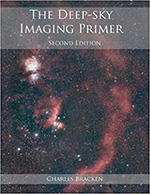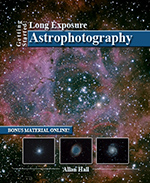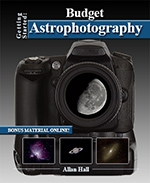Why look for the best astrophotography book? There is a lot of information online about astrophotography, including some very interesting videos. Somehow it seems that I get more out of a good book than all this skipping all over the place trying to find answers to questions I didn’t know I had.
That doesn’t mean it has to be an actual book, the best astrophotography book for you might be an ebook in some cases. Personally I prefer printed books for this particular subject because I tend to write notes in the margins as I read and that is just easier in a print book. Fortunately, most of these are available in both formats.
Astrophotography by Thierry Legault
This is easily one of the best astrophotography books of all time. If you think that books on astrophotography should not only be informative but drop-dead gorgeous, this may be the best astrophotography book for you.
Legault’s sections on the moon, planets and the sun are just jaw-dropping.
He is also excellent in not only telling you how things work but showing you examples. His examples of sharpening Jupiter and Saturn on page 97 are impressive, to say the least.
Anyone interested in astrophotography will find this an incredibly useful book. He covers a wide range of astrophotography topics from wide field to deep space long exposure. There really is a reason this book consistently gets five-star reviews on Amazon.
I expected problems reading this book as it seems it was originally written in French and then translated. I can honestly say the translation was excellent and I have no problems at all with anything in the book.
You can also see more of his astrophotography work on his website at astrophoto.fr and his YouTube channel at www.youtube.com/user/thlegault.
Available in both print ($31.63) and Kindle ($17.27).
The Deep-sky Imaging Primer by Charles Bracken
Unlike Astrophotography by Legault above, this book is more like Long Exposure Astrophotography by Hall below in that it does not deal much with planetary, solar, or lunar. It is almost exclusively devoted to deep-sky objects, as it should be.
While this may sound strange, I love love love the paper this book is printed on. While it is in full color, it is also a matt non-glossy paper that makes it much easier to read. Sure, the images are not as pretty as the high-gloss pages in Astrophotography, but the text and charts are much easier on the eyes like Hall’s books, but with color. Even if you have the best astrophotography book there is, if you don’t like reading it, it is useless.
This book seems to be aimed at the person who is really serious about astrophotography. There is little discussion on equipment capabilities instead of focusing on how things work. Once you understand how it all works, you can easily make decisions on what equipment you may need to purchase.
If you already are into astrophotography and want to take your abilities to the next level, this would be an excellent book.
Bracken divides his time well between all the aspects such as setting up, imaging and processing with a little emphasis on processing. This makes sense because processing is usually harder than imaging.
For a well-rounded book for people who are a little above total beginners, this may be your best astrophotography book.
Bracken has a WordPress blog at digitalstars.wordpress.com where he has some useful articles related to astrophotography.
Available in print edition ($42.70) only.
Getting Started: Long Exposure Astrophotography by Allan Hall
Mr. Hall has a real winner here which should be obvious by the fact that it was released in 2013 and continues to be in the top sellers and get glowing reviews. All the other books by different authors on this list are newer, and yet, it is just as good now as it was back then.
Hall takes the complete newcomer and starts with the absolute basics. The book is structured in such a way as it starts with the equipment you need for different levels of astrophotography and then goes all the way to hold your hand through the capture and processing portions.
Nothing is assumed, and his conversational tone makes it easy to read and keep pace. Gone are the complicated formulas (although there are a few simple ones) and scientific explanations. While he does explain the whys, he doesn’t dwell on them just to sound smart.
Another thing I like about Hall is that he didn’t stop with one book, he has a whole stable of them. He also supports them with his website at www.allans-stuff.com including bonus material for many books, and his YouTube channel at www.youtube.com/c/AllanHall which includes tons of tutorials and reviews related to astrophotography.
One downside, if you want to call it that, is that Hall chose to print his printed books in black and white (Kindle editions are in color). It seems he did this for two reasons; to save on the cost of the books, and because although pretty, the color really isn’t required for what he is teaching you.
I guess he was right because his books are far cheaper than the other books on this list. In fact, you could buy two of his books for the price of a comparable book by another author. That’s nice since astrophotography is inherently expensive.
If you are looking for something to start off a serious interest in astrophotography with, but are starting at the very beginning, then this might be the best astrophotography book for you. Available in both print ($16.14) and Kindle ($9.99).
The Astrophotography Manual by Chris Woodhouse
Woodhouse has one of the best astrophotography books on the market with a heavy focus on the processing of images. In fact, short of a book like Inside PixInsight by Warren A Keller, this book has the hands-down best processing section of any astrophotography book I have read.
The book has several targets he processes and for each one there is a wonderful flowchart showing the processing steps and order. These sections alone are worth the price of the book.
Fortunately, the processing sections are not the only things in the book. Woodhouse does a great job of covering the basics as well, from how things move above us, through equipment selection, taking images in the field, and finally to processing. This is an excellently well-rounded book.
I do have two little complaints; the text is a little small and the book is a little too textbook-like. At times it can be a tad dry and matter-of-fact. Those are minor complaints however because the quality of the content is absolutely first-rate.
Woodhouse has a nice little website at www.digitalastrophotography.co.uk where he has more information on astrophotography and some helpful video tutorials.
Available in print ($47.20), hardcover ($131.68) and Kindle ($47.36).
Getting Started: Budget Astrophotography by Allan Hall
That’s right, another book by Allan Hall. While his first book on this list concentrates on taking long exposures with dedicated astrophotography equipment, this one is more about getting cool images without spending much money.
Just like Hall’s last book, he starts at the beginning assuming little knowledge. Instead of expensive telescopes and mounts, he talks more about phones, point and shoot cameras, and cheap telescopes.
One unique part of this book is the good-sized DIY section that includes topics such as balancing a Dobsonian telescope, modifying a webcam for astrophotography, building a barn door tracker, building a Denver chair, and much more.
This is the best astrophotography book out there for people who want to take images on the cheap. Available in both print ($16.99) and Kindle ($9.99) editions.






